At first glance, the communication process seems simple enough: you reach out to someone, they understand what you mean, and they respond with an appropriate reaction.
But what about all those misinterpretations, missed cues, or times when your intention completely goes over someone’s head?
These issues occur because the communication process is ever-changing and depends on 8 interconnected factors.
In this article, we’ll lay the theoretical foundation of effective communication and explore how to apply it to communicate more effectively at work.
We’ll also hear from experts who’ll share some of their tried-and-true tips on improving the communication process and eliminating miscommunication.
Hopefully, these tips will help you fix your team’s core communication problems, prevent things from ever getting too chaotic, and minimize rework.
Ready? Let’s jump in.

What is the communication process?
The communication process is a sequence of actions necessary for effective communication. These actions ensure the successful transmission of meaning between at least two participants, helping them understand each other without issues.
However, sometimes things aren’t always as straightforward as they appear.
In reality, effective communication requires careful attention to the 8 interconnected elements that make up the communication process. When properly followed, the communication process can ensure the intended message is conveyed and understood without misinterpretation or confusion.
Let’s discuss the communication process and its formative elements to get a deeper understanding of the process.
What are the 8 elements of the communication process?
In the book The Process of Communication: An Introduction to Theory and Practice, communication theorist David K. Berlo hints at the fact that communication, like other processes, is dynamic and ever-evolving.
Essentially, this means that the topic changes depending on whom you’re speaking to, as do your tone of voice and body language. However, certain elements are universal for each interaction.
The 8 elements of the communication process are:
- Source (or Sender) — the person who initiates a conversation,
- Message — the purpose of the initiated communication,
- Channel — the means by which the message travels from the source to the receiver,
- Receiver — person or group of people receiving and interpreting the message,
- Feedback — the response the receiver returns as a reply to the message,
- Environment — the mental and physical contexts in which we communicate,
- Context — scene, setting, and expectations of the conversation participants, and
- Interference (noise) — anything that distorts or modifies the intended meaning of a message.
Now, let’s take a closer look at how all of these elements interact in order to create the communication process.
Understanding this will help you break down communication into steps, so you can pinpoint each one that you or your team may need to work on.
How does the communication process work?
There are 5 steps in the communication process. The basic steps of any conversation are:
- Idea formation,
- Message encoding,
- Message transmission,
- Message decoding, and
- Feedback.
The following model is also known as the transactional model of communication. Breaking down these communication cycle phases will help you better understand your role in conversation and improve your communication skills.

Step #1: The source or sender has an idea (Idea formation)
Communication begins with the source, or the message sender.
Several things can influence the message you want to convey. Before saying or writing anything, make sure to consider:
- Your and your interlocutor’s mood,
- Your respective positions within the company, and
- Your potentially different cultures.
The source should always think about how the receiver or audience will respond to the message.
One of the most invaluable skills of an effective communicator is the ability to adapt their message so that it elicits a positive response.
Step #2: The source encodes the idea in a message (Encoding)
Encoding consists of transforming an idea into gestures and words that carry meaning.
However, different people associate different meanings with the same words, which can bring up misunderstandings.
According to Guffey and Loewy in Business Communication: Process & Product, miscommunication that stems from mismatched meanings is called bypassing — one of the most common problems in professional communication.
To avoid these complications, use commonly used, easily understood words as often as you can. Your goal as the source is to establish a clear meaning of the core message with your interlocutor.
However, even if you do agree on the meaning, sharing a language with someone doesn’t mean you share the same business culture.
Let’s take a look at how language and culture can clash in a conversation on Pumble, a team communication app.
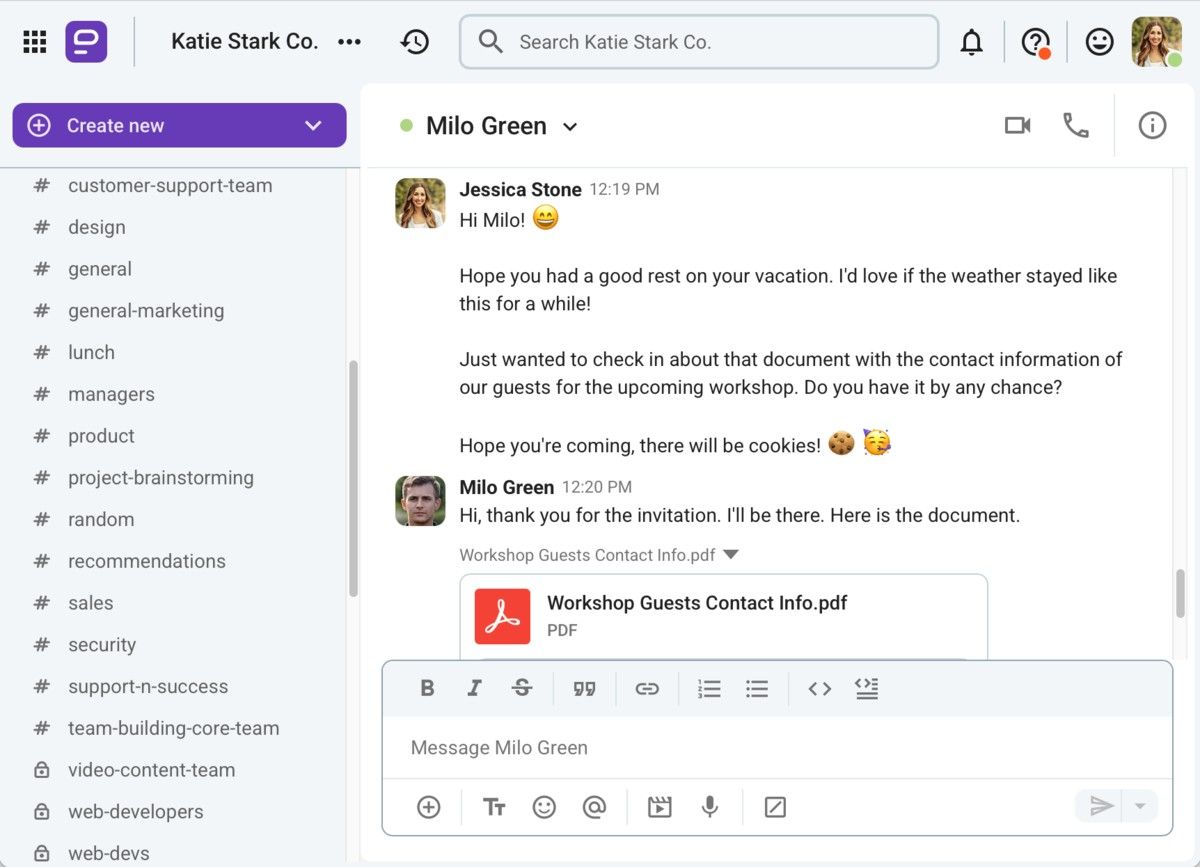
Jessica has sent a message to Milo, the new administration officer who has moved to the US from the UK. Jessica starts with casual chit-chat before diving into the point of her message.
While that is considered polite behavior in the US, it can grate on people from countries where it is customary to get to the point without veering off-topic.
Furthermore, Jessica uses the terms “vacation” and “cookies.” While these don’t throw Milo off, in the UK, it’s common to hear “holiday” or “biscuits”.
Finally, Milo’s response is brief and doesn’t venture into non-work-related territory. This can feel cold to Jessica, who is clearly used to different types of interactions.
🎓 Pumble Pro Tip
To learn how other differences such as culture, language, rules, and norms shape our communication, check out our blog post:
Step #3: The message is transmitted via a communication channel (Transmission)
During the communication cycle, it is necessary to find the best way to physically transmit the message to the receiver. The transmission medium is the communication channel. We can share messages via various channels, from phone calls and pictures to emails or business messaging apps.
Picking an effective communication channel can significantly impact how a receiver interprets both verbal and nonverbal messages.
In the example below, Emily is sharing the annual performance report with her colleagues. The tone present in the report, the document’s layout, and its design can all influence how the colleagues receive the message.
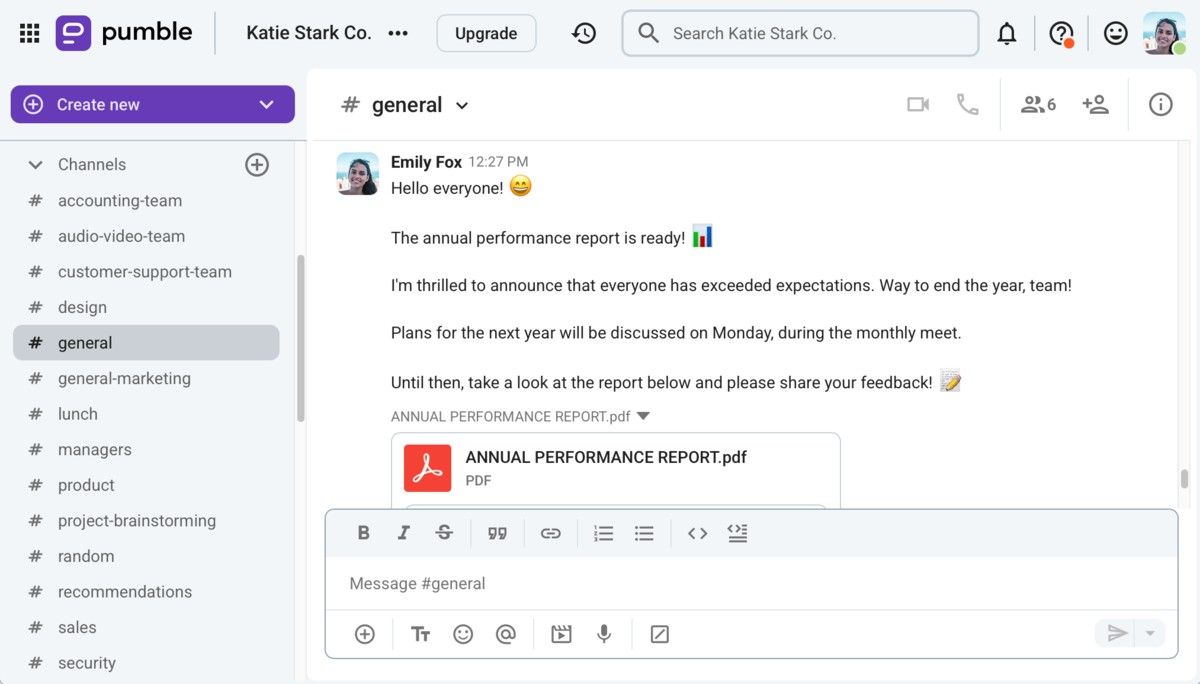
Share files securely via Pumble
Of course, before picking the most effective channel, you also need to consider the noise and how it could interfere with the communication process.
Here’s an example of noise and how it might disrupt communication:
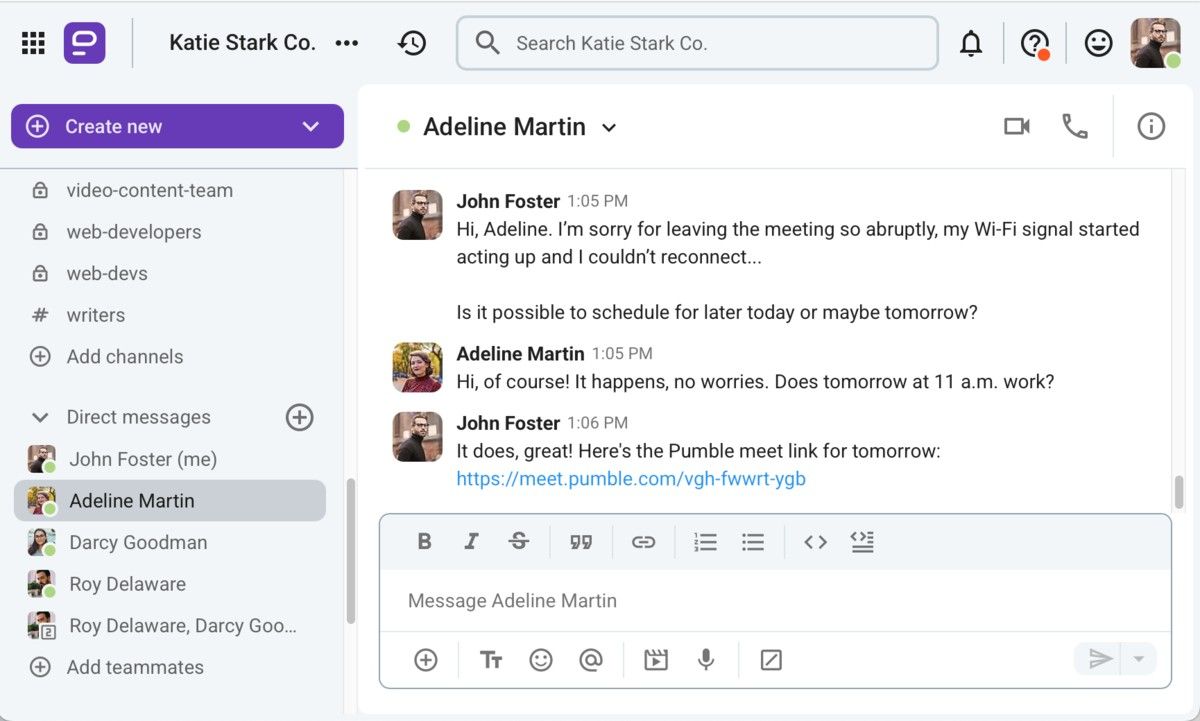
Interferences may take many forms, from misspellings in business emails to poor connection during a virtual video call.
However, choosing an unsuitable time to send an email or scheduling a team meeting for a simple update also counts as interference. This is an important thing to keep in mind when using digital tools for internal communication.
Step #4: The receiver decodes the message (Decoding)
Decoding occurs when the receiver analyzes the message and converts its symbols to uncover its meaning.
Successful communication can only happen when the receiver can comprehend what the source intended to say.
Because no two people share the same experiences and knowledge, and because numerous communication barriers can get in the way, decoding can easily become a challenging process.
Internal factors, such as a lack of attention when someone is speaking and prejudice, can cause issues with decoding. External factors, such as a loud environment or technical issues, could also cause misunderstandings or add to existing ones.
Communicate without technical issues in Pumble
However, semantic hurdles can also often cause severe communication issues. Let’s analyze the announcement below as an example:
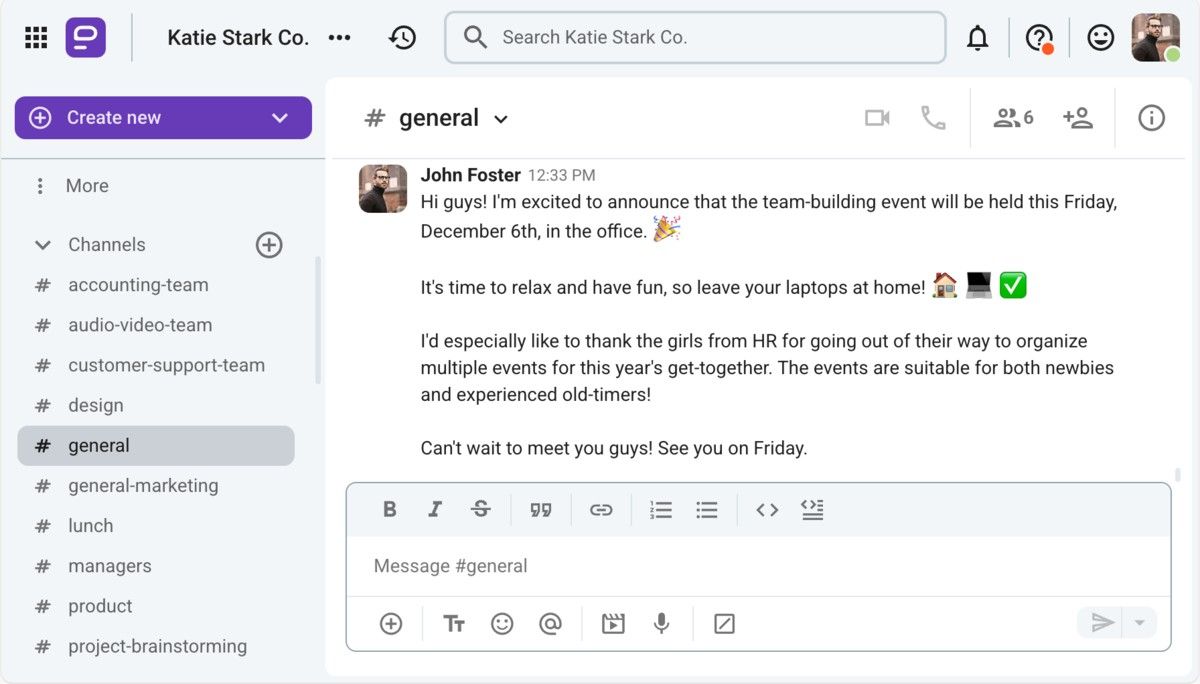
John has posted what he thinks is an exciting announcement about an upcoming company event. While his intentions are coming from the right place, his words have definitely missed the mark.
Referring to new hires as “newbies,” the female employees as “girls,” and seasoned employees as “oldtimers” has the potential to offend numerous people.
Thus, these word choices could lead to strong reactions that prevent the employees from focusing on the overall message.
Step #5: Feedback reaches the source
Feedback is the backbone of communication and covers the interlocutor’s nonverbal and verbal responses. These signals let the source know how someone has received and understood the message.
For example, when a coworker asks, “How’s your day going?” you can respond with, “Good, thanks. And yours?”. Or, if you’ve had a particularly draining day, you might just smile and shrug your shoulders.
In team communication apps, you could send a message, post a comment, or use an emoji to show how you feel.
In any case, it’s important to:
- Plan your delivery,
- Time it appropriately, and
- Give the interlocutor enough time to organize their thoughts.
Because different people share varying degrees of feedback, it’s also a good idea to encourage feedback in a workplace setting. You can do so with questions like “Is everything I’ve said clear?” or “Do you need clarification on anything I’ve mentioned?”
🎓 Pumble Pro Tip
Feedback in the context of communication process refers to a person’s immediate response, but you’ve probably encountered the type of feedback that refers to someone’s work or behavior. To learn more about giving and asking for this type of feedback in the workplace, check out:
Tips for improving the communication process
Now that we’re familiar with the 8 elements and 5 steps of the communication process, let’s focus on learning how to ensure the best possible outcomes.
Tip #1: Beware of bypassing
Bypassing is a phenomenon that happens when the source and receiver attach two completely different meanings to a single word or phrase.
For example, if you’ve just landed your first job after graduating from university, seeing “meeting cadence” mentioned in a message from your manager might confuse you.
You could immediately think of the more well-known definition of the word “cadence,” which is the inflection of someone’s voice. But, your manager is referring to the frequency of team meetings, and that could take a while to straighten out and get on the same page.
The good news is that business communication doesn’t have to be convoluted. You can prevent bypassing if you:
- Avoid using business jargon in the workplace,
- Use simple and clear language, and
- Proofread your messages and emails to eliminate spelling errors and vague wording.
Tip #2: Strive to be a more attentive listener
Even if someone structures their message with care, their efforts will go to waste if the other person is a poor listener.
Fortunately, active listening is a skill, and you can learn how to leverage it to your advantage in business communication.
In Communication in Business: Strategies and Skills, Judith Dwyer cites Gamble and Gamble (1996), who have identified 6 common behaviors most poor listeners exhibit:
- Dart thrower: Questioning the speaker and the validity of their story as soon as they make a mistake, no matter how minor it is.
- Ear hog: Dominating the communication situation by pushing your story and preventing others from telling their side.
- Bee: Only listening to parts of the conversation that interest you the most and ignoring everything else.
- Earmuff: Sidetracking the conversation to avoid confronting specific information.
- Gap filler: Coming up with additional information to prove you’ve heard the whole story, although you only zeroed in on parts of it.
- Nodder: Feigning listening by pretending to pay attention to the speaker. In reality, you are thinking about a different topic entirely.
Sometimes, we do the things above completely unintentionally. That’s exactly why it’s essential to try to take a step back and strive to communicate without unconscious biases.
According to Joanna Staniszewska, a seasoned marketing, communication, and HR professional, communication is a two-way street, and active listening is one of the most effective strategies:

“Actively listening to others fosters trust and understanding. Encourage individuals to:
- Pay attention,
- Ask questions, and
- Confirm their comprehension during conversations.”
🎓 Pumble Pro Tip
Do you want to get more tips on becoming a present and attentive listener? If so, we have just the post for you:
Tip #3: Create an environment that encourages feedback
Establishing stable feedback loops positively impacts employee engagement, creating a safe space for people to self-advocate at work.
If you manage a team, this method can be useful both for employee recognition and resolving conflicts before they develop into large-scale issues.
Staniszewska mentioned relying on sustainable feedback loops:

“Emphasize the need for feedback mechanisms that allow individuals to assess their communication effectiveness continually. This can be formal, like surveys, or informal, like regular team check-ins.”
To create a positive feedback loop, you must:
- Manage your emotions,
- Always lead the conversation with empathy, and
- Give feedback in real time.
Here’s an example of how to effectively communicate and create this environment as a manager:
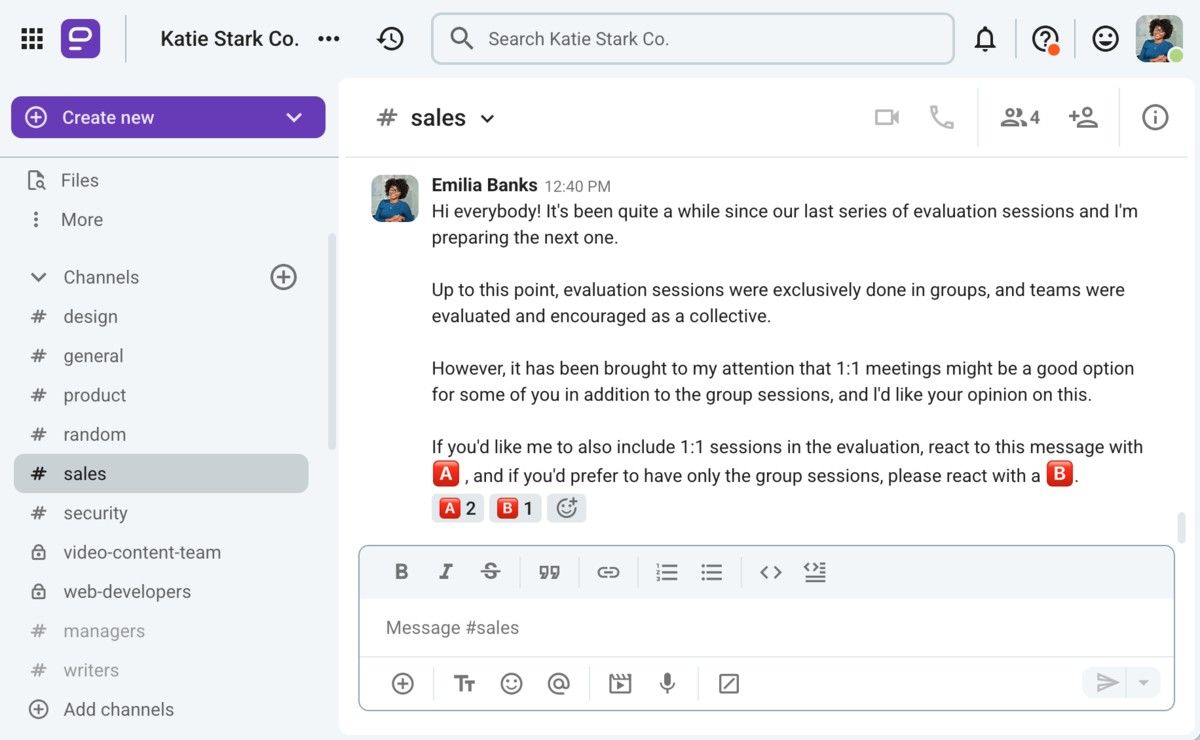
When eliciting feedback, remember not to rush the interaction, states Dawid Wiacek, a communication and executive career coach:

“In today’s business landscape, speed is often a competitive advantage, but when it comes to success in communication, one of the keys is actually slowing down. To ensure the other person has digested your message accurately, it’s helpful to ask them to summarize it in their own words.”
Wiacek also offered some advice on how to properly do that:

“You can ask:
- What resonated about the message and what didn’t,
- What they felt was the core element, and what was secondary,
- What was validating and perhaps surprising.
The point here is you want to engage the recipient and make sure that the original message was translated appropriately and not lost in translation.”
Provide feedback more efficiently with Pumble
Tip #4: Think about background differences
Although it can be nerve-wracking, giving feedback to colleagues is the most essential part of virtually all jobs.
Ideally, we deliver feedback in a constructive and empowering manner, but that’s not always how things pan out. Even without intending to offend someone, a situation may come up as a result of cultural, work, or other background differences.
Let’s take the below exchange as an example.
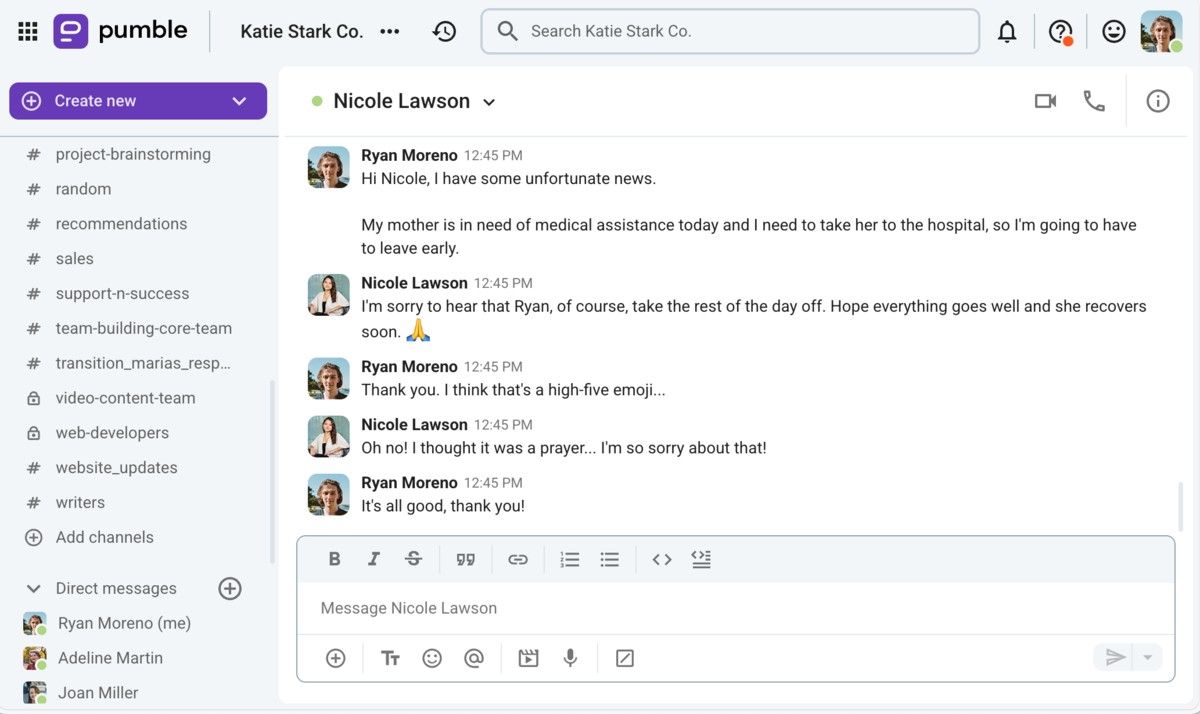
Nicole (from the US), sends her well wishes to Ryan, who has been working from Japan for the past 6 years. A minor misunderstanding arises because Nicole assumed Ryan would interpret the meaning of an emoji in the same way she does.
This type of blunder can sometimes be easy to handle — in this case, Nicole and Ryan were able to clear the air quickly and move on.
However, all employees should be strategically encouraged to adapt and be mindful of potential differences, to avoid any potential tension or a major falling out.
Joanna Staniszewska highlighted the importance of cultural intelligence and sensitivity:

“Communication takes place in diverse environments. Stress the importance of cultural awareness and sensitivity. Encourage individuals to adapt their communication styles to resonate with the audience’s cultural norms and expectations.”
Tip #5: Understand different communication styles
Understanding your preferred communication style and aligning it with your coworkers can make a big difference in team collaboration.
When someone abruptly shuts down during the communication process, it might not be because of something you’ve intentionally said or done.
For example, although you thought you were assertively standing up for your idea, your coworker could have felt like you were subtly attacking theirs.
The core issue? The difference between your communication styles.

Connect with your team on Pumble
If you often find yourself in similar situations, a combination of social awareness and self-awareness can help you bolster your emotional intelligence. Gradually, working on this will help you gain more control over how you speak and act in the workplace.
In the case you need more guidance, another strategy would be enrolling in a professional development course that could help you become a more transparent and flexible communicator.
🎓 Pumble Pro Tip
For more extensive information on different communication styles, as well as becoming more flexible during business communication, check out this guide:
Tip #6: Take into account the changing demographics of the workforce
As a team leader, you need to figure out how to connect and collaborate with colleagues from different generations, and inspire others to do so as well.
Since we all have specific habits and preferences, the generational gap can also put our behavior at odds with that of our older or younger coworkers.

Navigating these differences and refraining from resorting to stereotypes is the way to go when creating a well-connected and inclusive environment.
Be entirely honest about your preferred ways of communication and respect the boundaries of your team members. As soon as they notice these efforts, they’ll feel more at ease when asking for help or reaching out about a work task.
🎓 Pumble Pro Tip
Are you interested in learning more about enhancing communication across generations within your team or company? Then check out:
Why is the communication process important?
Through the way we communicate, we learn not only how to get ahead in life but also how to form stable relationships.
Understanding the communication process:
- Affects how we view others and ourselves,
- Affects the way we learn, and
- Helps us put our best foot forward.
When you work in a team, how you communicate can paint a positive image of both you and your coworkers. When your communication style reflects professionalism and respectfulness, reaching agreements and negotiating deals becomes much less of a hassle.
Paired with an excellent work ethic, strong communication is a huge plus when it comes to advancing to a leadership position as well. And, should you decide to change companies, sharp oral and written communication skills will significantly improve your employment prospects.
🎓 Pumble Pro Tip
If you make a misstep while joining a new team, good communication can help you iron out any lingering issues. But, to avoid these awkward situations altogether and learn how to make a good first impression, check out the blog post below:
Use Pumble to make your team’s communication process easy
Knowing what the communication process is and why it matters will give you a head start in reaching the next level when developing your team.
In this context, integrating a tool designed to simplify communication helps you optimize your communication channels and foster meaningful connections in the workplace.
For this job, look no further than Pumble — the all-in-one team communication app.
Pumble simplifies communication for hybrid, remote, and on-site teams by offering features that streamline your team’s written and verbal communication efforts, such as:
- Channels – dedicated spaces for simplifying communication by notifying groups of people quickly,
- Threads – message replies for topic navigation in channels (perfect for feedback loops),
- DMs – for 1:1 conversations and future reference,
- Video conferencing – for face-to-face team conversations and strengthening trust through visual feedback,
- Meeting recording – to revisit important team conversations and eliminate any unconscious biases,
- Unlimited message history – to access messages from the very day you created your workspace and further refine your communication process,
- File sharing with global search – to find important documents shared by your team all the way to day one and streamline your information distribution.
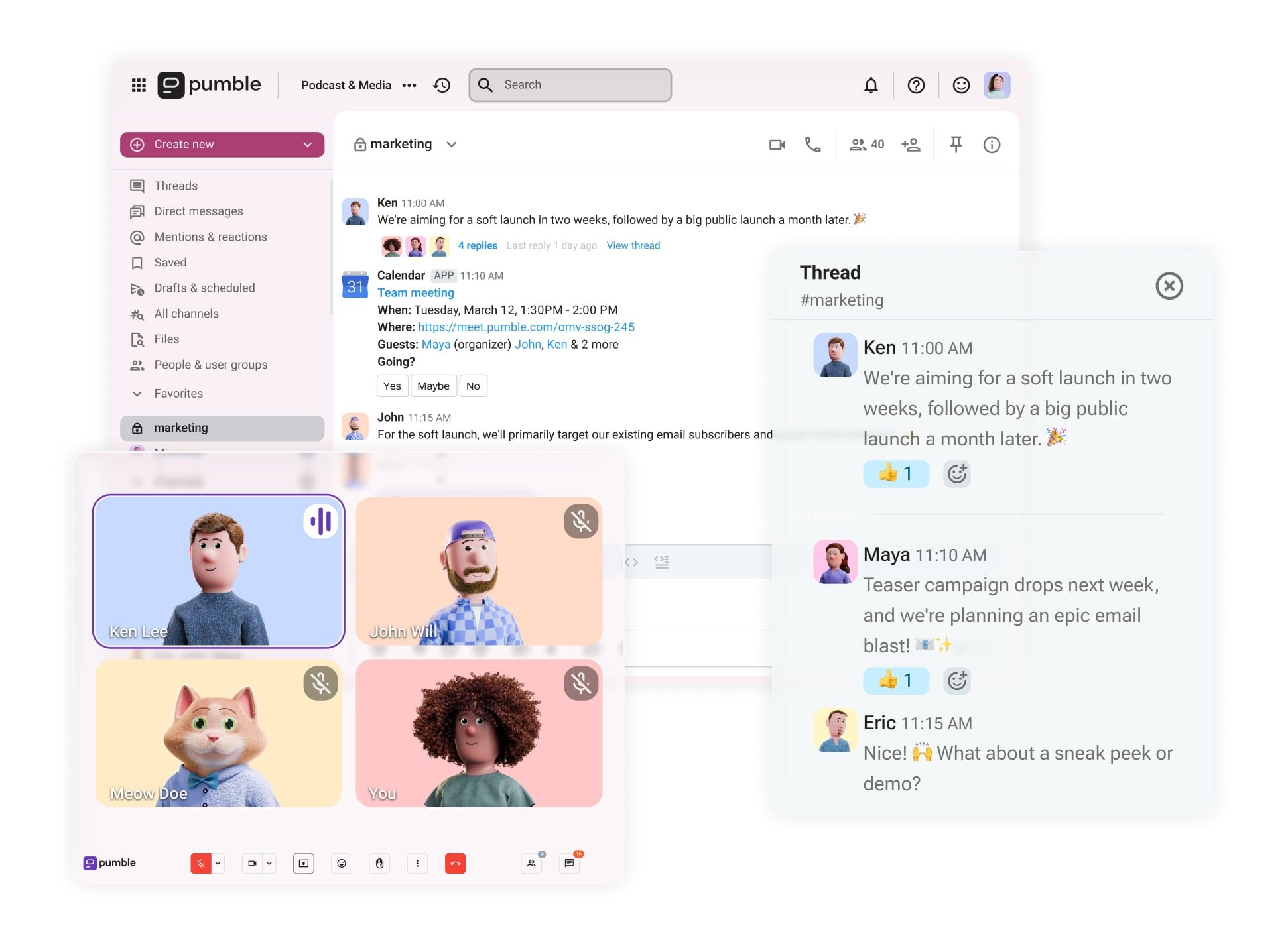
With its intuitive interface and real-time messaging features, Pumble addresses the main communication challenges such as information overload and siloed channels. Pumble replaces email as a highly customizable all-in-one communication hub (helping you bypass information overload) and allows you to connect everyone through relevant channels (to reduce the chances of silos forming).
By integrating Pumble into your communication process, you can:
- Foster transparency,
- Streamline team workflows, and
- Enhance team cohesion.
Simplify the communication process for your team today.
How we reviewed this post: Our writers & editors monitor the posts and update them when new information becomes available, to keep them fresh and relevant.


